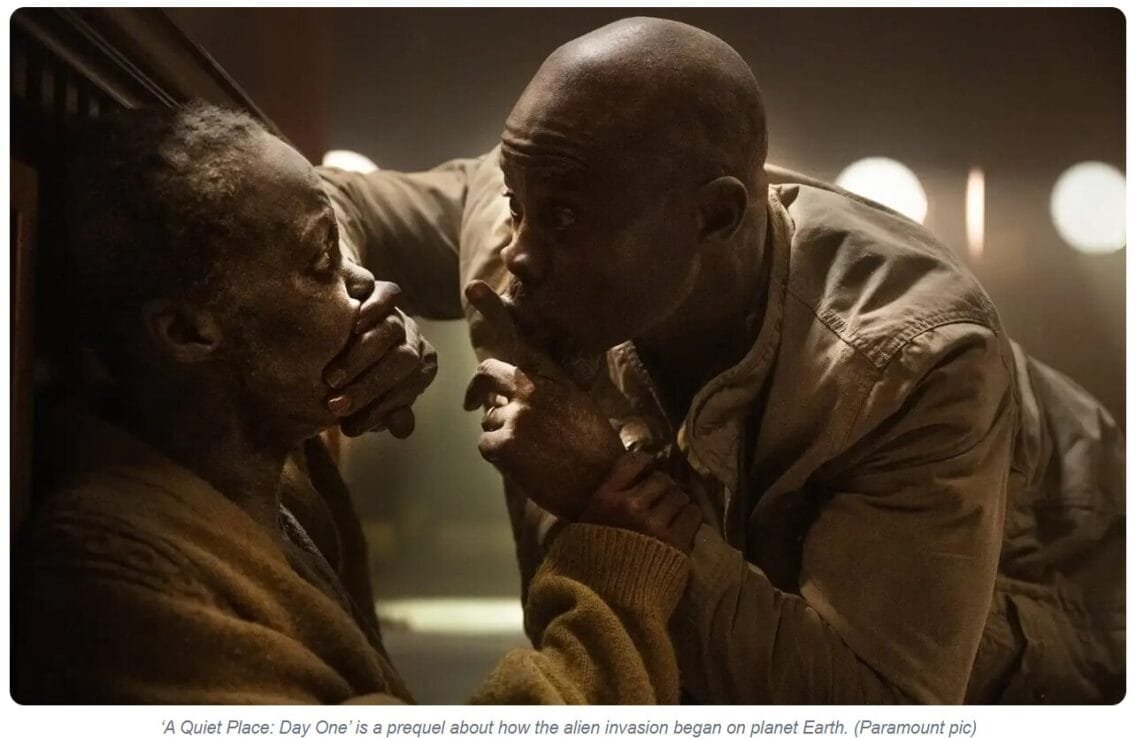Horror Movie Review: A Quiet Place: Day One

Rating: 6.5/10
Star Ratings: ⭐⭐⭐/⭐⭐⭐⭐⭐
As the latest entry in the A Quiet Place franchise, A Quiet Place: Day One attempts to take audiences back to the terrifying moment when humanity first encountered the lethal, sound-sensitive aliens. This prequel, directed by Michael Sarnoski, sets its scenes in New York City, introducing new characters and a new atmosphere. Unfortunately, the film struggles to live up to the intense, fresh scares of its predecessors, relying too heavily on well-worn tropes and offering little in terms of innovation.
Plot Overview
The story revolves around Samira (Lupita Nyong’o), a poet diagnosed with terminal cancer, who finds herself in the heart of New York City as the alien apocalypse unfolds. After the chaos begins, Samira, determined to fulfill a personal desire to enjoy her final slice of New York pizza, embarks on a treacherous journey through the now desolate and dangerous streets of Manhattan. Along the way, she encounters Eric (Joseph Quinn), a panicked law student, and the two form a tenuous partnership as they navigate the silent terror around them.
The premise itself is intriguing—how would the bustling, noisy city of New York react to a sudden need for silence? The film sets up the city’s ambient noise levels (reportedly averaging 90 decibels), hinting at a terrifying challenge. Yet, as many critics pointed out, the movie fails to deliver on this potential. The urban setting feels more like a sterile set, lacking the gritty realism of actual New York, as much of the filming took place on soundstages in London. This disconnect between setting and narrative weakens the film’s immersion.
Atmosphere and Execution
One of the main criticisms levied against A Quiet Place: Day One is its lack of truly scary moments. While the original A Quiet Place and its sequel delivered heart-pounding tension—like the iconic birth scene or the claustrophobic hiding sequences—Day One tends to rehash the same formula of silence-shattering noise followed by alien attacks, but without the same intensity or suspense. The sense of repetition quickly dulls any real terror.
Despite this, Lupita Nyong’o shines in her portrayal of Samira, infusing the character with both vulnerability and resilience. Her character’s fatalistic outlook and personal journey add emotional depth to an otherwise predictable narrative. The interactions between Samira and Eric are well-acted, but Eric remains somewhat underdeveloped, with his backstory largely unexplored. Joseph Quinn delivers an emotional performance, particularly during his character’s panic attacks, but as Roger Ebert’s site notes, there simply isn’t enough material to elevate his character beyond a trope
Missed Opportunities
One of the greatest disappointments of the film is its failure to expand on the lore of the alien invasion. Prequels often succeed when they offer new perspectives or revelations about events that audiences think they already know. Unfortunately, Day One contributes very little to the overall mythology. Where previous installments unveiled crucial weaknesses of the creatures—such as their sensitivity to water or high-frequency sounds—this film doesn’t offer any new insights.
This lack of innovation extends beyond just the creatures. The film’s pacing feels rushed, with little time devoted to meaningful character development or world-building. As many reviewers have pointed out, at only 99 minutes, the film feels like it could have benefited from a longer runtime to allow for greater emotional investment and more tension
Roger Ebert. In fact, the most compelling moments—such as a tense confrontation involving a panicked man that questions how far someone would go to protect their family—are too few and far between.
The Positives
That being said, A Quiet Place: Day One isn’t without merit. Sarnoski’s direction showcases moments of nuance, particularly in the wordless exchanges between characters. Nyong’o and Quinn carry much of the film with their physical performances, conveying fear, desperation, and fleeting moments of hope through their expressions and movements. The film also continues to excel in its use of sound (or the absence thereof) as a narrative device, drawing out tension through periods of silence that are punctuated by sudden bursts of chaos.
The emotional support cat, Frodo, adds an unexpected charm to the story, breaking up the tension with some lighter moments. Additionally, the film’s central theme—facing one’s mortality while the world crumbles around them—is handled with sensitivity and offers a poignant undercurrent to the survival horror.
Conclusion
Overall, A Quiet Place: Day One is a mixed bag. It successfully carries over some of the strengths of the original films, particularly in its performances and use of sound, but it falls short in terms of scares, narrative innovation, and character development. While it offers a few standout moments and Lupita Nyong’o’s performance is captivating, the film ultimately feels like a retread of familiar ground.
For fans of the A Quiet Place franchise, this prequel may offer some enjoyment, but don’t expect it to reach the heights of its predecessors. With its predictable story and limited world-building, it’s hard to shake the feeling that this franchise might be running out of steam. If you’re looking for fresh, bone-chilling horror, you might want to look elsewhere.
Verdict
- Scares: ⭐⭐⭐/⭐⭐⭐⭐⭐
- Storyline: ⭐⭐/⭐⭐⭐⭐⭐
- Acting: ⭐⭐⭐⭐/⭐⭐⭐⭐⭐





